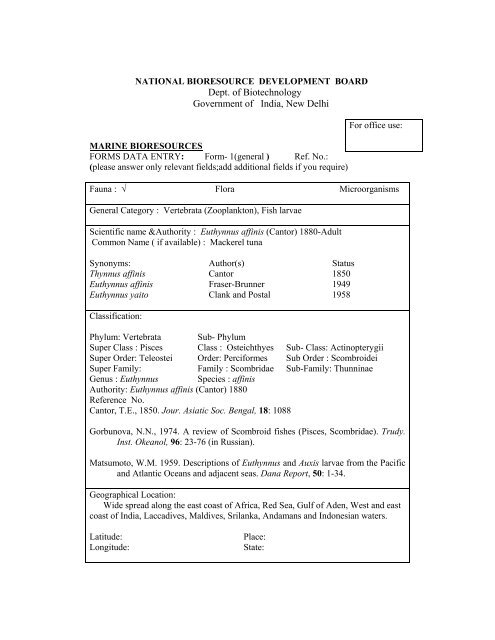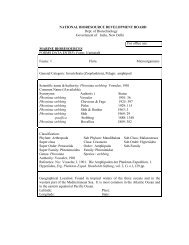Euthynnus affinis - NIO Bioinformatics Website
Euthynnus affinis - NIO Bioinformatics Website
Euthynnus affinis - NIO Bioinformatics Website
Create successful ePaper yourself
Turn your PDF publications into a flip-book with our unique Google optimized e-Paper software.
NATIONAL BIORESOURCE DEVELOPMENT BOARD<br />
Dept. of Biotechnology<br />
Government of India, New Delhi<br />
MARINE BIORESOURCES<br />
FORMS DATA ENTRY: Form- 1(general ) Ref. No.:<br />
(please answer only relevant fields;add additional fields if you require)<br />
Fauna : √ Flora Microorganisms<br />
General Category : Vertebrata (Zooplankton), Fish larvae<br />
Scientific name &Authority : <strong>Euthynnus</strong> <strong>affinis</strong> (Cantor) 1880-Adult<br />
Common Name ( if available) : Mackerel tuna<br />
Synonyms:<br />
Thynnus <strong>affinis</strong><br />
<strong>Euthynnus</strong> <strong>affinis</strong><br />
<strong>Euthynnus</strong> yaito<br />
Classification:<br />
Phylum: Vertebrata<br />
Super Class : Pisces<br />
Super Order: Teleostei<br />
Super Family:<br />
Genus : <strong>Euthynnus</strong><br />
Author(s)<br />
Cantor<br />
Fraser-Brunner<br />
Clank and Postal<br />
Sub- Phylum<br />
Class : Osteichthyes<br />
Order: Perciformes<br />
Family : Scombridae<br />
Species : <strong>affinis</strong><br />
Authority: <strong>Euthynnus</strong> <strong>affinis</strong> (Cantor) 1880<br />
Reference No.<br />
Cantor, T.E., 1850. Jour. Asiatic Soc. Bengal, 18: 1088<br />
Status<br />
1850<br />
1949<br />
1958<br />
Sub- Class: Actinopterygii<br />
Sub Order : Scombroidei<br />
Sub-Family: Thunninae<br />
Gorbunova, N.N., 1974. A review of Scombroid fishes (Pisces, Scombridae). Trudy.<br />
Inst. Okeanol, 96: 23-76 (in Russian).<br />
Matsumoto, W.M. 1959. Descriptions of <strong>Euthynnus</strong> and Auxis larvae from the Pacific<br />
and Atlantic Oceans and adjacent seas. Dana Report, 50: 1-34.<br />
Geographical Location:<br />
Wide spread along the east coast of Africa, Red Sea, Gulf of Aden, West and east<br />
coast of India, Laccadives, Maldives, Srilanka, Andamans and Indonesian waters.<br />
Latitude:<br />
Longitude:<br />
Place:<br />
State:<br />
For office use:
Environment<br />
Fresh water: Yes/ No<br />
Brackish : Yes / No<br />
Salt water : Yes√ / No<br />
Habitat :<br />
Migrations :<br />
Depth range :<br />
Picture (scanned images or photographs of adult / larval stages)<br />
Salinity :<br />
Temperature :<br />
Figs. 1 – 6. Larvae of <strong>Euthynnus</strong> <strong>affinis</strong><br />
Fig. 1 – 3.45 mm; Fig. 2 – 4.8 mm; Fig. 3 – 5.4 mm<br />
Fig. 4 – 6.1 mm; Fig. 5 – 7.1 mm; Fig. 6 – 8.4 mm; Fig. 7 – 9.1 mm.<br />
(Reproduced from Gorbunova, 1974)
DATA ENTRY FORM: Form- 2(Fish / shellfish / others ) Ref.No.:<br />
(please answer only relevant fields ; add additional fields if you require)<br />
Form –1 Ref.No.:<br />
IMPORTANCE<br />
Landing statistics (t/y) : from to Place : Ref . No.:<br />
Main source of landing: Yes/ No Coast: east/ west<br />
Importance to fisheries:<br />
Main catching method :<br />
Used for aquaculture : yes/ never/ rarely<br />
Used as bait : yes/no/ occasionally<br />
Aquarium fish : yes/ no/ rarely<br />
Game fish : yes/ no<br />
Dangerous fish : poisonous/ harmful/ harmless<br />
Bioactivity : locally known/ reported/ not known Details:<br />
Period of availability : Throughout the year – yes/ no If no, months:<br />
SALIENT FEATURES :<br />
Morphological:<br />
Diagnostic characteristics:<br />
Sex attributes:<br />
Descriptive characters:
Meristic characteristics:<br />
Feeding habit:<br />
Main food :<br />
Feeding type :<br />
Additional remarks:<br />
Size and age:<br />
Maximum length (cm) (male / female/ unsexed)<br />
Average length (cm) (male / female / unsexed)<br />
Maximum weight : (g) (male / female / unsexed)<br />
Average weight :(g) (male / female / unsexed)<br />
Longevity (y) (wild) : (captivity )<br />
Length / weight relationalships:<br />
Ref. No.:<br />
Ref. No.:<br />
Ref. No.:<br />
Ref. No.:<br />
Ref. No.:
Eggs and larvae:<br />
Ref . No.:<br />
Information on eggs is not available. Ripe ovum is reported to be of having an<br />
average diameter of 0.99 mm with single oil globule of 0.25 mm.<br />
Larval stages are characteristically long and slender and head conspicuously large.<br />
The abdominal sac is triangular, small and anteriorly situated. The vent is far forward<br />
of the mid point of total length. Eye diameter is more than the length of snout in early<br />
stages. Seven preopercular spines could be distinguished. There are 39 myomeres, of<br />
which 20 are precaudal and 19 caudal. Teeth are present on both jaws.<br />
Pigments are present on the membrane covering the brain and the sides of the<br />
head. An important distinguishing character is the presence of an irregular row of dark<br />
chromatophores along the posterior portion of the ventral midline, and a series of 4 or<br />
5 chromatophores in anterior half of the mandible. (Figs. 1-7)<br />
Characteristics:<br />
Abundance:<br />
Biochemical aspects:<br />
Proximate analysis: moisture/ fat/ protein/ carbohydrate/ash Ref. No.<br />
Electrophoresis: Ref. No.<br />
SPAWNING INFORMATION:<br />
Locality: Main Ref:<br />
Spawning ground appears to be within the 200 km line from the coast. Off<br />
Vizhinjam the probable period of spawning of this species is between April and<br />
September with peak in May – August. This differs in different parts of the Indian<br />
Ocean.<br />
Season:<br />
Fecundity:<br />
Comment:<br />
MAJOR PUBLICATIONS (INDIAN):<br />
(include review articles, monographs, books etc.)<br />
Jones, s. 1960. Notes on egg, larvae and juveniles of fishes from Indian waters.V .<br />
<strong>Euthynnus</strong> <strong>affinis</strong> (Cantor). Indian J. Fish., 7(1): 101-106.<br />
Jones, S., and M. Kumaran, 1964. Eggs, larvae and juveniles of Indian Scombroid<br />
fishes. Proc. Sym. Scomber. Fishes, Mandapam Camp, (Mar. Biol. Ass. India)<br />
1: 343-378.<br />
Peter, K.J., 1977. Distribution of tuna larvae in the Arabian Sea. Proc. Symp. Warm.<br />
WaterZool. Spl. Pbl. UNESCO/<strong>NIO</strong>, pp. 36-40.<br />
Peter, K.J., 1982. Studies on some fish larvae of the Arabian Sea and Bay of Bengal.<br />
Ph. D. Thesis, Univ. of Cochin, pp. 349.
LIST OF INDIAN EXPERTS (Name, address, phone, fax, e-mail etc.)<br />
1. Dr. K.J.Peter<br />
Scientist, <strong>NIO</strong>. (Rtd)<br />
Koithara<br />
54/2950, Kadavanthara South<br />
Kochi-682020<br />
Ph. (0484) 318036<br />
e-mail: peterann@md4.vsnl.net.in<br />
2. Mr. M. Kumaran<br />
Scientist CMFRI (Rtd.)<br />
Malamparambil Housing Colony<br />
Calicut – 673 009<br />
ACKNOWLEDGEMENT:<br />
(List of persons who contributed, modified or checked information)



